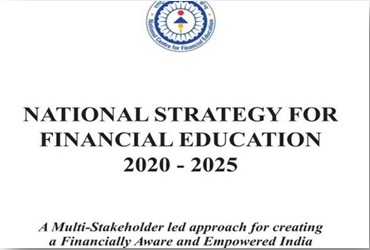|
Syllabus: Prelims GS Paper I : Current Events of National and International Importance; Economic and Social Development-Sustainable Development, Poverty, Inclusion, Demographics, Social Sector Initiatives, etc.
Mains GS Paper III: Indian Economy and issues relating to Planning, Mobilization of Resources, Growth, Development and Employment; Inclusive Growth and issues arising from it.
|
Context
Reserve Bank of India has introduced 5-year national strategy for financial education.
Background
The Reserve Bank of India released a national strategy for financial education to be implemented in the next five years, the central bank added that the approach is aimed to create a financially aware and empowered Indian society.
The document NSFE (2020-2025) is prepared by the National Centre for Financial Education (NCFE). It was prepared in consultation with the four financial sector regulators and other relevant stakeholders.
|
National Centre for Financial Education (NCFE)
It is a Section 8 (Not for Profit) Company promoted by Reserve Bank of India (RBI), Securities and Exchange Board of India (SEBI), Insurance Regulatory and Development Authority of India (IRDAI) and Pension Fund Regulatory and Development Authority (PFRDA).
It aims to undertake massive Financial Education campaign to help people manage money more effectively to achieve financial well being by accessing appropriate financial products and services through regulated entities with fair and transparent machinery for consumer protection and grievance redressal.
In Detail
|
The Reserve Bank of India (RBI) came out with a ‘5-Core Actions’ approach for promoting the financial education, which among other things include development of relevant content for school children and adults, community participation and collaboration among various stakeholders. The ‘National Strategy for Financial Education 2020-2025′ (NSFE), released by the RBI, has suggested a multi-stakeholder led approach for creating a financially aware and empowered India. The five Cs, outlined by the strategy paper, are Content, Capacity, Community, Communication and Collaboration.
It also makes a case for integrating financial education in courses like B.Ed./M.Ed. besides other teacher's training courses to create a cadre of financially educatd teaching professionals. It calls for development of a financial literacy mobile app, and leverage social media.
The Technical Group on Financial Inclusion and Financial Literacy (TGFIFL) would be responsible for periodic monitoring and implementation of National Strategy for Financial Education. There would also be periodic monitoring of the activities undertaken by various stakeholders for dissemination of basic, sector-specific, and process literacy.
| Financial literacy - It is defined as a combination of financial awareness, knowledge, skills, attitude, and behaviour necessary to make sound financial decisions and ultimately achieve individual financial well-being. |
Objective of the Scheme
To inculcate financial literacy concepts among the various sections of the society through financial education and encourage active savings behaviour. Among the other strategic objectives to encourag participation in financial markets to meet financial goals and objectives, developing credit discipline and encourage availing credit from formal financial institutions as per requirement, and improving usage of digital financial services in a safe and secure manner.
Its key objectives includes to educate on managing risk at various life stages through relevant and suitable insurance cover and plan for old age and retirement through coverage of suitable pension products.
The document stresses on development of financial literacy content for school children (including curriculum and co-scholastic), teachers, young adults, women, new entrants at workplace/entrepreneurs (MSMEs), senior citizens, persons with disabilities, illiterate people.
Conclusion
Strengthening financial inclusion in the country has been one of the important developmental agendas of both the Government of India and the four financial sector regulators (RBI, SEBI, IRDAI and PFRDA). Financial literacy supports the pursuit of financial inclusion by empowering the customers to make informed choices leading to their financial well-being.
Connecting the Article
Question for Prelims
With reference to the National Centre for Financial Education, consider the following statements:
1. It is is the premier financial policy ‘Think Tank’ of the Government of India.
2. It aims to promote financial education across India for all sections of the society.
Which of the statements given above is/ are correct ?
(a) 1 only
(b) 2 only
(c) Both 1 and 2
(d) Neither 1 nor 2
Question for Mains
Discuss the challenges for financial literacy in India.

 Contact Us
Contact Us  New Batch : 9555124124/ 7428085757
New Batch : 9555124124/ 7428085757  Tech Support : 9555124124/ 7428085757
Tech Support : 9555124124/ 7428085757







